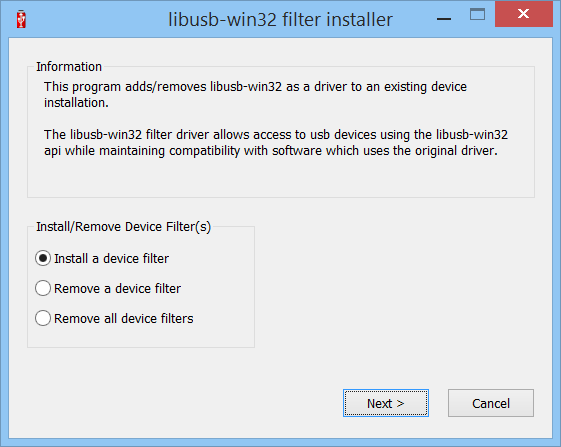Install Libusb Windows 10
Nov 01, 2016 Windows 10 IoT (on Raspberry Pi 2) has the WinUSB driver (found in C: windows system32 winusb.dll) but I can't get Windows 10 IoT to use this driver for my device. I tried to install it using the INF-file found here. Because that INF-file refers to amd64 I made some minor changes to it to hopefully make it ARM compatible.
I tried to compile the libusb-sys v1.2.6.0 project with Visual Studio community 2013 and WinDDK v7600.16385.1. And get two error messages as below: 1>C: Program Files (x86) MSBuild Microsoft.Cpp v4.0 V120 Microsoft.MakeFile.Targets(38,5): error MSB3073: The command 'CD 'D: LibUSB1260 libusb-win32-src-1.2.6.0 projects.
Ddk_make' 1>C: Program Files (x86) MSBuild Microsoft.Cpp v4.0 V120 Microsoft.MakeFile.Targets(38,5): error MSB3073: CMD /C make.cmd 'arch=x86' 'app=driver' 'noclean=true' 'outdir=D: LibUSB1260 libusb-win32-src-1.2.6.0 projects Win32 Debug libusb-sys ' 'DIR_INTERMEDIATE=D: LibUSB1260 libusb-win32-src-1.2.6.0 projects Win32 Debug libusb-sys ' 'debugmode=true' exited with code 1. By the way, I had modified the make.cfg file and NMake Including Search Path setting based on my environment.
I have a generic USB device that I want to use in Windows 10 IoT. The device is WinUSB compatible as I can get it to work with WinUSB on regular Windows (through ). Windows 10 IoT (on Raspberry Pi 2) has the WinUSB driver (found in C: windows system32 winusb.dll) but I can't get Windows 10 IoT to use this driver for my device.

I tried to install it using the INF-file found. Because that INF-file refers to amd64 I made some minor changes to it to hopefully make it ARM compatible. I used files found in. Replace the Vendor ID (VID) and Product ID (PID) in [Standard.NTarm] with the corresponding VID and PID of the USB you're adding. Finally replace the ManufacturerName and DeviceName near the bottom with the correct info for your device. Put this file somewhere on the Raspberry Pi 2, using either SMB or FTP.
Write something about yourself. No need to be fancy, just an overview. No Archives Categories. Sooronbaj zhusuevdin irlari. Write something about yourself. No need to be fancy, just an overview. No Archives Categories.
SSH or PowerShell to the Raspberry Pi 2 and go to the folder where you put the INF file. Cp dp. Run the following command: devcon dp_add. You should see the following result: Driver package 'oem0.inf' added. Finally restart the RP2 ( shutdown -r -t 0 from SSH/PowerShell). When the RP2 gets back up your device should be listed under 'Connected Devices' on the default startup app, and you should now be able to use functionality from Windows.Devices.Usb to communicate with the USB device.